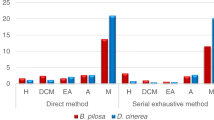Abstract
A novel tetrazolium salt, 3-(4,5-dimethylthiazol-2-yl)-5-(3-carboxymethoxyphenyl)-2-(4-sulphophenyl)-2H-tetrazolium (MTS) was used in the assessment of antimicrobial activity in earthworm in the presence of phenazine methosulphate (PMS) as an electron coupling reagent. This activity was purified from the coelomic fluid of the earthworm (ECF),Eisenia fetida andrei (Oligochaeta, Lumbricidae, annelids) using a series of column chromatography techniques and was tested against three Gram-negative strains ofEscherichia coli, Pseudomonas aeruginosa, Aeromonas hydrophila and three Gram-positive strains ofStaphylococcus aureus, Bacillus megaterium, Arthrobacter sp., respectively. Only the pigment-free eluate of coelomic fluid of the earthworm (ECFPE) showed activity againstB. megaterium amongst three isolated active fractions. The anion (DEAE-52) exchange effluent of the ECFPE was reported to have the strongest activity againstP. aeruginosa amongst the three active fractions. The 20% acetonitrile eluate (AE) by Sep-Pak C18 cartridge was also tested and showed fair resistance againstE. coli, P. aeruginosa andArthrobacter sp., respectively.
Similar content being viewed by others
Abbreviations
- AE:
-
Acetonitrile eluate
- DPBS:
-
Dulbecco’s phosphate buffered saline
- ECF:
-
coelomic fluid of the earth-worms
- ECFPE:
-
ECF pigment-free eluate
- MICs:
-
minimum inhibitory concentrations
- MTS:
-
3-(4,5-dimethylthiazol-2-yl)-5-(3-carboxymethoxyphenyl)-2-(4-sulphophenyl)-2H-tetrazolium
- PMS:
-
phenazine methosulphate
References
Bradford M M 1976 A rapid and sensitive method for the quantitation of microgram quantities of protein utilizing the principle of protein-dye binding;Anal. Biochem. 72 248–254
Hirigoyenberry F, Lassègues M and Roch P 1992 Antibacterial activity ofEisenia fetida andrei coelomic fluid: Immunological study of the two major antibacterial proteins;J. Invertebr. Pathol. 59 69–74
Jollés P and Zuili S 1960 Purification et étude comparée de nouveaux lysozymes extraits du poumon de poule et deNephtys hombergi;Biochim. Biophys. Acta 39 212–217
Lassègues M 1986Etude des activités antibactériennes humorales et cellulaires du lombricien Eisenia fetida andrei, Thèse Doctorat ès-Sciences, Université de Bordeaux 1
Lassègues M, Roch P and Valembois P 1989 Antibacterial activity ofEisenia fetida andrei coelomic fluid: Evidence, induction, and animal protection;J. Invertebr. Pathol. 53 1–6
Lassalle F, Lassègues M and Roch P 1988 Protein analysis of earthworm coelomic fluid-IV. Evidence, activity induction and purification ofEisenia fetida andrei lysozyme (annelidae);Comp. Biochem. Physiol. B91 187–192
Lehrer R I, Rosenman M, Harwig SSL, Jackson R and Eisenhauer P 1991 Ultrasensitive assays for endogenous antimicrobial polypeptides;J. Immunol. Methods 137 167–173
Meletiadis J, Mouton J W, Meis J F G M, Bouman B A, Donnelly J P, Verweij P E and Eurofung Network 2001 Colorimetric assay for antifungal susceptibility testing ofAspergillus species;J. Clin. Microbiol. 39 3402–3408
Milochau A, Lassègues M and Valembois P 1997 Purification, characterization and activities of two hemolytic and antibacterial proteins from coelomic fluid of the annelidEisenia fetida andrei;Biochim. Biophys. Acta 1337 123–132
Moore K S, Bevins C L, Brasseur M M, Tomassini N, Turner K, Eck H and Zasloff M 1991 Antimicrobial peptides in the stomach ofXenopus laevis;J. Biol. Chem. 266 19851–19857
Roch P 1979 Protein analysis of earthworm coelomic fluid. 1. Polymorphic system of the natural hemolysin ofEisenia fetida andrei;Dev. Comp. Immunol. 3 599–608
Schubert I and Messner B 1971 Untersuchungen über das vorkommen von lysozym bei anneliden;Zool. Jahrb. Physiol. Bd. 76 36–50
Turnidge J, Bell J, Biedenbach D J and Jones R N 2002 Pathogen occurrence and antimicrobial resistance trends among urinary tract infection isolates in the Asia-western Pacific Region: report from the SENTRY Antimicrobial Surveillance Program, 1998’1999;Int. J. Antimicrob. Agents 20 10–17
Valembois P, Roch P, Lassègues M and Cassand P 1982 Antibacterial activity of the hemolytic system from the earthwormEisenia fetida andrei;J. Invertebr. Pathol. 40 21–27
Author information
Authors and Affiliations
Corresponding author
Rights and permissions
About this article
Cite this article
Pan, W., Liu, X., Ge, F. et al. Reconfirmation of antimicrobial activity in the coelomic fluid of the earthwormEisenia fetida andrei by colorimetric assay. J Biosci 28, 723–731 (2003). https://doi.org/10.1007/BF02708433
Received:
Accepted:
Issue Date:
DOI: https://doi.org/10.1007/BF02708433




